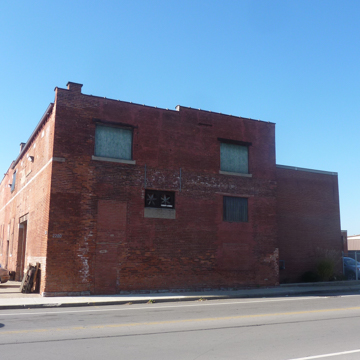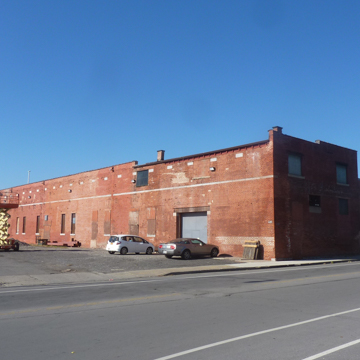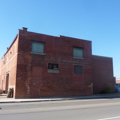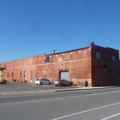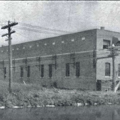Terminal A
In the late nineteenth century, the Buffalo-Niagara region attracted worldwide interest when the first long-distance transmission of electricity occurred by traveling through the Terminal A Building. Hydroelectric power generated at Niagara Falls traveled over twenty miles to Buffalo, was transformed at Terminal A, and then sent out to a receiving station on a momentous day in November 1896. Nikola Tesla’s insistence on alternating current triumphed over Thomas Edison’s direct current system, proving to the world that alternating current electricity would illuminate the new age. Used first to power streetcars, streetlights, and factories, the transmission of electricity from Niagara Falls to Buffalo marked a pivotal moment in the history of the nation and the world.
Designed by architect Louise Bethune in close collaboration with Nikola Tesla, the Cataract Power and Conduit Company’s Terminal A was the first alternating current power transforming station in the world. This two-story brick building with rectangular massing and open interior plan may today be an unassuming box-like structure at 2280 Niagara Street, but houses a powerful history. The building was integral to the process of safely distributing electricity across long distances, serving as the main transformer hub in a larger network of stations. All of this power was received from Niagara Falls, transformed, and sent out again from Terminal A. The building was a pivotal point in the process of distributing electricity efficiently, as it was essential to transform the voltage so as to be able to send it safely to other stations. The unadorned exterior brick walls belie the complexity of equipment once inside, used to step-down the voltage before sending it off to power the Buffalo Trolley line and later, the city’s booming industrial mills.
This major electrical innovation simply would not have worked without the Terminal A Building, yet the structure was largely ignored by the press. Meanwhile, the Adams Powerhouse complex designed by McKim, Mead, and White in Niagara Falls was a million-dollar national public relations event. Bethune’s building, conversely, was rarely mentioned, and the only major photograph of it appears in the electrical age journal in 1906, thirteen years after the initial breakthrough occurred.
Bethune is rarely, if ever, mentioned in the extensive writings about the War of Currents. Although she laid out a prototype for this modern building type, it was McKim, Mead, and White who received public attention and critical praise for their powerhouse building in Niagara Falls instead. The Ecole des Beaux Arts–trained firm designed their limestone-clad powerhouse with plenty of traditional ornament to “soften” the image of electricity, whereas Bethune remained aesthetically honest about Terminal A’s industrial and plain-faced functions. Given that the Ecole des Beaux Arts still did not enroll women at the time this building was constructed anyway, Bethune shrugged off some of the dominant architectural traditions she was denied access to and instead embraced an affinity for technological modernity in her design. Her professional reputation for a no-nonsense approach likely helped her secure the commission, even if it also worked against her in ensuring she would remain mostly in the background of the studies that followed.
Terminal A was largely forgotten over the next century, only to be “rediscovered” more recently in the last decade. Today, the building remains vacant, boarded, and derelict along the Niagara River near a highway. Some developers have expressed interest in rehabilitating the building for new uses, but nothing has yet come to fruition. It has also yet to receive historic designation. Bethune’s architectural contribution to the history of hydroelectricity may have fallen into shadow, but the building remains hidden in plain sight.
References
Adams, Edward Dean. Niagara Power. Niagara Falls, NY: Niagara Falls Power Company, 1927.
Andrews, William. "How Niagara Has Been Harnessed." American Monthly Review of Reviews, June 1901.
Buck, Harold. “The Buffalo High-Tension Cable Distribution System.” Street Railway Review 12, no. 1 (January 15, 1902).
“Buffalo and Niagara Falls Notes.” Electrical World 38 (July 2, 1898): 12.
Cataract Power and Conduit Company. Niagara Power. Buffalo, NY: Cataract Conduit Company, 1906.
Electric World and Engineer, December 10, 1905.
“Cataract Power and Conduit Company Terminal.” Electrical Age (January 1906).
“Great Tesla: A Perfect Success.” Buffalo Enquirer (Buffalo, NY) July 20, 1896: 2.
Hays, Johanna. Louise Blanchard Bethune: America’s First Female Professional Architect. Jefferson, NC: McFarland & Company, Inc., 2014.
Hill, H. W. Municipality of Buffalo, New York—A History: 1720–1923. New York: Lewis Historical Publishing Co., 1923.
“Niagara’s Power in Buffalo: The Plant That Sent Electricity over a Twenty-Two-Mile Course.” New York Times, November 17, 1896: 9.
“Power from Niagara Falls.” Electrical Age 19, no. 23 (June 5, 1897): 357.
“Run by Falls Power.” Buffalo Express/Commercial Advertiser (Buffalo, NY), November 19, 1896.
“Tesla There: Power Here By November.” Buffalo Morning Express (Buffalo, NY), July 20, 1896: 1.
Writing Credits
If SAH Archipedia has been useful to you, please consider supporting it.
SAH Archipedia tells the story of the United States through its buildings, landscapes, and cities. This freely available resource empowers the public with authoritative knowledge that deepens their understanding and appreciation of the built environment. But the Society of Architectural Historians, which created SAH Archipedia with University of Virginia Press, needs your support to maintain the high-caliber research, writing, photography, cartography, editing, design, and programming that make SAH Archipedia a trusted online resource available to all who value the history of place, heritage tourism, and learning.














